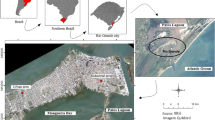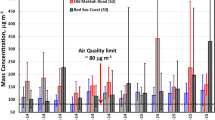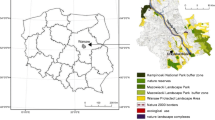Abstract
Total suspended particulate matter and deposition fluxes of particles were investigated in the town of Didouche Mourad which is located 13 km north of Constantine. Samples of air particulate matter were collected at one site located in the heart of the town and situated 3 km north of a cement plant. Samples were collected from 2 November 2002 to 28 April 2003 every 3 days using a high volume air sampler. Sampling intervals were 24 h in all cases. During the same period, samples of dust fallout were collected at the same site. Samples were collected at 30-day intervals. Lead, chromium, manganese, nickel, copper, cobalt and cadmium deposition fluxes were measured and both the soluble and insoluble fractions were determined. Furthermore, the information gathered by this study was correlated with the corresponding hourly weather data provided by a weather station installed at the study station. The possible sources for dust and trace metals were analyzed by comparing average contributions of wind aspects to the concentrations and depositions of mass and chemical species with the average frequencies of wind direction. The mean concentration was 300 μg/m3. The average dust deposition rate through the period of study was 221 mg/(m2.day). Results indicate that anthropogenic sources contribute greatly to trace elements. An exposure assessment to the heavy metals taking into account the inhalation route and soil dust ingestion was carried out and allowed direct comparison of trace metal intakes via these routes.
Similar content being viewed by others
References
Agency for Toxic Substances and Disease Registry (ATSDR) (1999a). Public health statement. In: Toxicological profile for lead (pp. 13–17). Atlanta, GA: U.S. Department of Health and Human Services, Public Health Service.
Agency for Toxic Substances and Disease Registry (ATSDR) (1999b). Appendix A. ATSDR minimal risk levels and worksheets. In: Toxicological profile for cadmium (pp. 3–6). Atlanta, GA: U.S. Department of Health and Human Services, Public Health Service.
Agency for Toxic Substances and Disease Registry (ATSDR) (2000). Regulations and advisories. In: Toxicological profile for chromium (pp. 328–332). Atlanta, GA: U. S. Department of Health and Human Services, Public Health Service.
Agency for Toxic Substances and Disease Registry (ATSDR) (2001). Appendix A. ATSDR minimal risk levels and worksheets. In: Toxicological profile for cobalt. Draft for public comment (pp. 3–7). Atlanta, GA: U.S. Department of Health and Human Services, Public Health Service.
Agency for Toxic Substances and Disease Registry (ATSDR) (2002). Appendix A. ATSDR minimal risk levels and worksheets. In: Toxicological profile for copper – Draft for public comment (pp. 3–4). Atlanta, GA: U.S. Department of Health and Human Services, Public Health Service.
Agency for Toxic Substances and Disease Registry (ATSDR) (2003). Appendix A. ATSDR minimal risk levels and worksheets. In: Toxicological profile for nickel (pp. 3–5).Atlanta, GA: U.S. Department of Health and Human Services, Public Health Service.
Barnes, D. G., & Dourson, M., (1998). Reference dose (RfD): Description and use in health risk assessments. Regulatory Toxicology and Pharmacology, 8, 471–486.
Bem, H., Gallorini, M., Rizzio, E., & Krzeminska, M. (2003). Comparative studies on the concentrations of some elements in the urban air particulate matter in Lodz City of Poland and in Milan, Italy. Environment International, 29, 423–428.
Binder, S., Sokal, D., & Maughan, M. A. (1986). Estimating soil ingestion: The use of trace elements in estimating the amount of soil ingested by young children. Archives of Environment Health, 41, 341.
California Environmental Protection Agency (1997). Determination of chronic toxicity reference exposure levels, (Draft), CalEPA.
Clausing, P., Brunekreef, B., & van Wijnen, J. H. (1987). A method for estimating soil ingestion by children. International Archives of Occupational and Environmental Health, 59, 73.
Drill, S., Konz, J., Mahar, H., & Morse, M. (1979). The environmental lead problem: An assessment of lead in drinking water from a multimedia perspective. Report No EPA-570/9-79-003, U.S. Environmental Protection Agency.
Environment Agency (2003). Air quality criteria. In: Monitoring of particulate matter in ambient air around waste facilities. Technical guidance document (Monitoring) M17 (pp. 23–32). Bristol, UK: Environment Agency.
Hassanien, M. A. (2001). Assessment of human exposure to atmospheric trace metals in a residential area of Cairo, Egypt. Central European Journal of Occupational and Environmental Medicine, 7(3–4), 253–262.
IRIS (1996). US EPA. Data file for Nickel, soluble salts. In: Integrated Risk Information System, updated January 12.
Koçak, M., Nimmo, M., Kubilay, N., & Herut, B. (2004). Spatio-temporal aerosol trace fsmetal concentrations and sources in the Levantine Basin of the Eastern Mediterranean. Atmospheric Environment, 38, 2133–2144.
Kubilay, N. N., Saydam, A. C., Yemenicioglu, S., Kelling, G., Kapur, S., Karaman, C., et al. (1997). Seasonal chemical and mineralogical variability of atmospheric particles in the coastal region of the Northeast Mediterranean. Catena, 28, 313–328.
LaGrega, M. D., Buckingham, P. L., & Evans, J. C. (1994). Appendix B: Toxicological data. In: Hazardous waste management (pp. 1053–1077) Singapore: McGraw-Hill.
Organisation Mondiale de la Santé (OMS) (1987). Rapport de la 30 e réunion du Comité mixte FAO/OMS d’experts des additifs alimentaires, Rome, 2–11 juin, 1986, Genève.
Qin, Y., & Oduyemi, K. (2003). Chemical composition of atmospheric aerosol in Dundee, UK. Atmospheric Environment, 37, 93–104.
Shakour, A. A., Hassanien, M. A., & El-Taieb, N. M. (2001). Atmospheric heavy metals in the industrial area north Cairo, Egypt. Central European Journal of Occupational and Environmental Medicine, 7, 245–252.
TA-Luft (1986). Erste allgemeine Verwaltungsvorschrift zum Bundes-Immissionsschutzgesetz (Technische Anleitung zur Reinhaltung der Luft vom 27.2.1986). In: GMBI. 95.
TA-Luft (2002). Erste Allgemeine Verwaltungsvorschrift zum Bundes-Immissionsschutzgesetz (Technische Anleitung zur Reinhaltung der Luft Vom 24. Juli 2002). In: GMBI. 95.
U.S. Environmental Protection Agency (1986). Air quality criteria for lead. Report No EPA-600/8-83/028F.
U.S. Environmental Protection Agency (1999). Determination of metals in ambient particulate matter using atomic absorption (AA) spectroscopy, Compendium method IO-3.2. In Compendium of methods for the determination of inorganic compounds in ambient air (pp. 1–22). Cincinnati, OH: Center for Environmental Research Information, Office of Research and Development, U.S. Environmental Protection Agency.
WHO (1989). Cadmium. In Evaluation of certain food additives and contaminants. Thirty-third Report of the Joint FAO/WHO Expert Committee on Food Additives, Technical Report Series No. 776 (pp. 28–31). Geneva: World Health Organization.
WHO (2000). Inorganic pollutants. In Air quality guidelines for Europe, 2nd ed., European Series, No.91 (pp. 125–174). Copenhagen: Regional Office for Europe, WHO Regional Publications.
World Bank Group (1998). Airborne particulate matter. In Pollution prevention and abatement handbook (pp. 201–207). World Bank Group.
Author information
Authors and Affiliations
Corresponding author
Rights and permissions
About this article
Cite this article
Ali-Khodja, H., Belaala, A., Demmane-Debbih, W. et al. Air quality and deposition of trace elements in Didouche Mourad, Algeria. Environ Monit Assess 138, 219–231 (2008). https://doi.org/10.1007/s10661-007-9792-1
Received:
Accepted:
Published:
Issue Date:
DOI: https://doi.org/10.1007/s10661-007-9792-1




